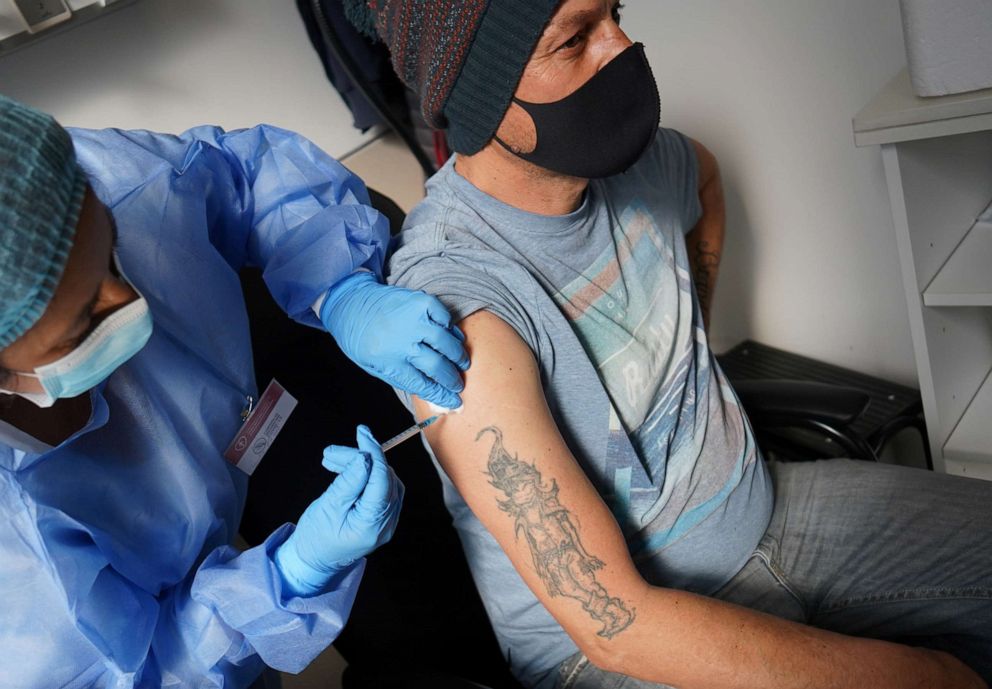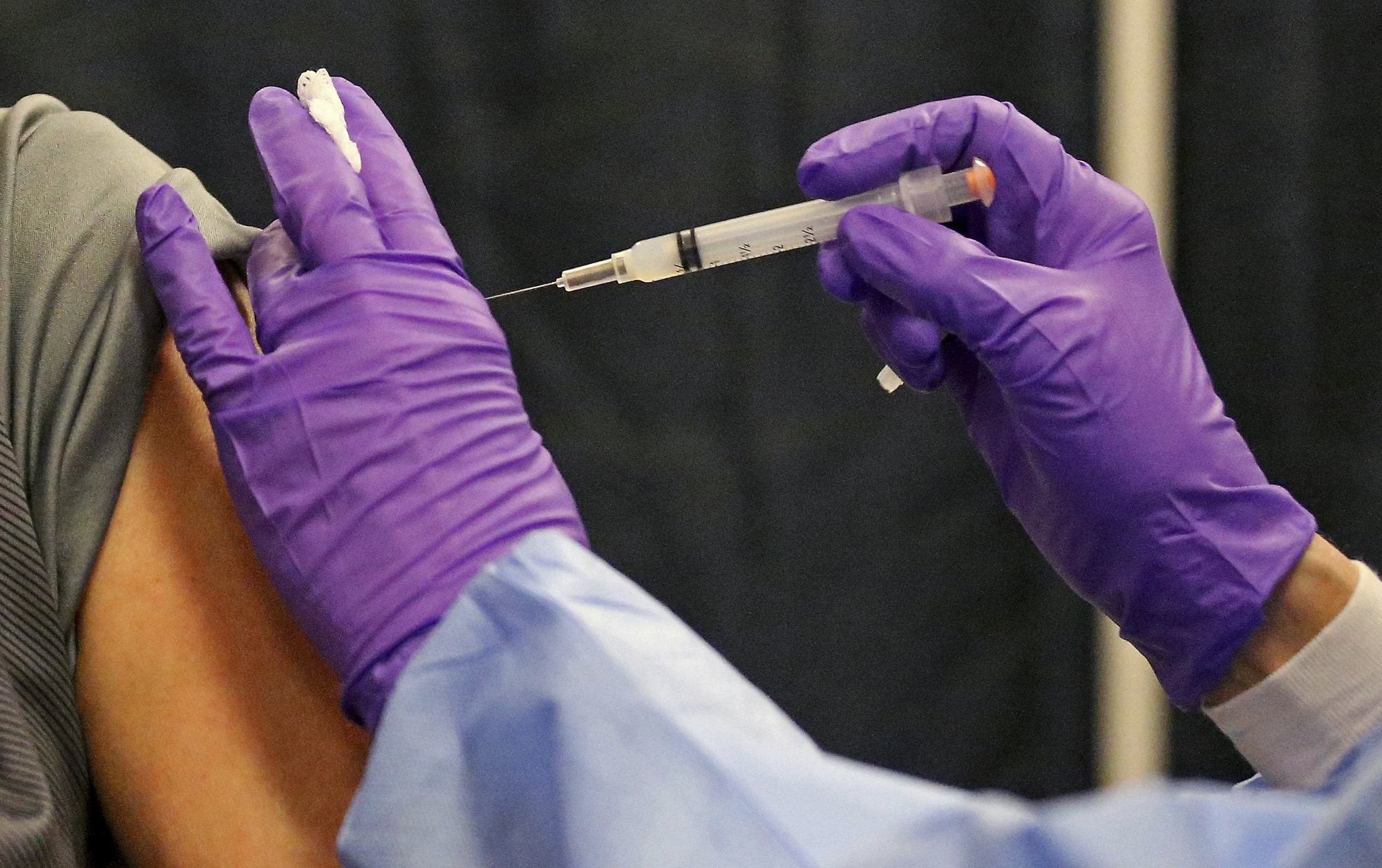Combating COVID vaccine misinformation in Black and Latino communities: OPINION
Latinos are twice as likely as white adults to contract the virus.
The highly contagious and deadly delta variant of the COVID-19 virus accounts for 90% of new COVID cases in the U.S., according to the Centers for Disease Control and Prevention. This variant continues to disproportionately affect infection and mortality rates in Black and Latino communities.
Latinos are twice as likely as white adults to contract the virus and 2.3 times more likely to die from it, according to the CDC. While Black adults contract the virus at the same rate as white adults, they’re twice as likely to die from the disease, the CDC said.
In an April ABC News/Washington Post poll, Black and Hispanic respondents all signaled a higher intent than white respondents to get vaccinated when looking strictly at the Johnson & Johnson vaccine. Recent CDC data for vaccinations across Moderna, Pfizer, and J&J shows persisting inequities in vaccination rates. Fully vaccinated Black Americans were only at 9.1% in the U.S. in comparison to fully vaccinated Latinos at 15.9% and White Americans are at 59.4%.
Despite the desired intent for vaccination, there are still barriers preventing increased vaccination rates. One of the main reasons for inequities in vaccination rates by race and ethnicity is the significant misinformation about vaccines and lack of health education.

Confronting misinformation head-on can increase vaccine rates and save lives. Here are five ways to do that:
1. Meet people where they are
A survey conducted by the Kaiser Family Foundation found that when it came to understanding why Hispanic adults were not following through on their intentions to get vaccinated, they expressed concerns about missing work and having difficulty traveling to a vaccine site.
There’s an easy way to overcome this challenge. Instead of waiting for people to come to the vaccine, bring the vaccine to them. Some experts have called for pop-up vaccination sites in places where people often go outside of working hours, at subway and bus stations, public parks and back-to-school events. Some states and cities are looking at incentives such as lotteries, celebrity meetups and access to exclusive concerts in the community to motivate others. More jurisdictions are also advancing homebound vaccinations.
Evidence has also shown that partnering with community businesses like barbershops and beauty salons can improve public health.
For example, St. Louis County, Missouri, recently announced an initiative called Sleeves Up STL that enlists local barbershops and beauty salons to provide information to their customers about getting the vaccine.
Damon Broadus, director of Health Promotion and Public Health Research for the St. Louis County Department of Public Health, told Fast Company that in certain zip codes he’s seeing 1% to 4% increases in vaccinations every week at neighborhood clinics because of programs like Sleeves Up STL.
“In four weeks, that’s 16 percentage points," he told the outlet.
2. Use trusted messengers
Some experts say that who people hear from can be as important as what they’re hearing.
“People are wary of the pandemic as being overblown,” said Dr. Stacy Wood, professor of marketing at North Carolina State University. She recommends having people who have suffered from the disease speak at churches and other community locations.
“I think there’s a lot of power there, because it takes that media filter away and makes people think that it's much more trustworthy,” she told ABC News.
Elevating voices of health care heroes as trusted messengers is another way to curb fear and enhance trust, such as the national grassroots campaign of #ThisIsOurShot, a coalition of health care experts who are using social media to dispel misinformation and build vaccine trust. Health care providers are on Facebook, Instagram and TikTok answering questions for the public on vaccines.
Earlier this month, the Medicare Advantage insurer SCAN Health Plan announced that it had substantially reduced vaccine disparities among its Black and Latino members, in part by setting up a phone line that enabled members to get their questions answered and even to book vaccine appointments. SCAN isn’t the only insurer that’s had success like this. Commonwealth Care Alliance, an organization in Massachusetts that cares for vulnerable populations, launched an outreach program to find out which of its members were unvaccinated and help them schedule appointments to close the gap in vaccination rates. Cigna offered its members free rides to vaccination sites.
3. Curb the power of social media to spread misinformation
Misinformation is deadly when it influences people not to get vaccinated. “Modern technology companies have enabled misinformation to poison our information environment, with little accountability to their users,” Surgeon General Vivek Murthy recently warned.

That’s why it’s time to start holding social media companies responsible for false information. A bill proposed by Minnesota Sen. Amy Klobuchar would allow people to sue social media companies that distribute health misinformation related to the pandemic, something they currently cannot do under Section 230 of the Communications Decency Act.
Those that are providing care are also being held accountable for misinformation. The Federation of State Medical Board announced that physicians found to be spreading misinformation may risk disciplinary action, including revocation of their license.
4. Choose words carefully
Language can matter and make individuals more fearful of the vaccine or dismiss it altogether because of the possibility of infection even though one is vaccinated. A possible reason for this could be the continual use of the term “breakthrough infections” to describe infections that affect vaccinated people. The word “breakthrough” suggests a virus powerful enough to render vaccines useless but we know that vaccines are not 100% effective. The key to remember for everyone is that vaccination prevents severe disease and hospitalization. The vast majority of individuals in intensive care units are unvaccinated, according to a recent ABC News survey.
But that gives way too much credit to this virus. As Dr. Anthony Fauci, the federal government’s top infectious disease expert, recently noted: “The breakthrough infections – namely infections that occur in the setting of full vaccination – were mild in 96%, moderate in 3%, severe in less than 0.05%, with death in less than 0.05%.”
In other words, even if you get sick after getting vaccinated, that illness is likely to be mild and almost certainly won’t lead to hospitalization or death. So let’s stop using the phrase “breakthrough infections” and just call them what they are: plain old infections.
5. Pay attention to health literacy
Limited or insufficient health literacy is associated with a reduced adoption of protective behaviors such as getting immunized. Nearly 36% of adults in the U.S. have low health literacy, according to the Center for Health Care Strategies. Clearly written and accessible health information are key to increasing health education. Culturally sensitive and linguistically appropriate methods to advance equity and improve quality have proven effective.
For example, The Conversation Project worked with Black and Latino doctors, nurses and community health workers to amplify how important vaccinations are to their communities. Acknowledging cultural norms, hesitancies and addressing language barriers can help improve vaccination rates in minority communities.
Sometimes, health literacy can come in the form of art, music and dance. Recently, the Chicago Department of Public Health engaged the creative talents of more than 80 local artists to design original art exploring themes of health, vitality, community, and vaccine distribution to encourage everyone to get vaccinated.
The truth is, it will take some time before everyone feels comfortable being vaccinated. But through targeted outreach, one-on-one conversations and concerted efforts addressing the needs of all of America’s diverse communities, we can beat this pandemic through inclusivity, compassion and equity.
Dr. Jay Bhatt is an internal medicine physician, an instructor at the University of Illinois School of Public Health and an ABC News contributor. Dr. Asha Shajahan is the graduate medical education director of health equity and disparities at Beaumont Health and a primary care physician in Metro-Detroit.



